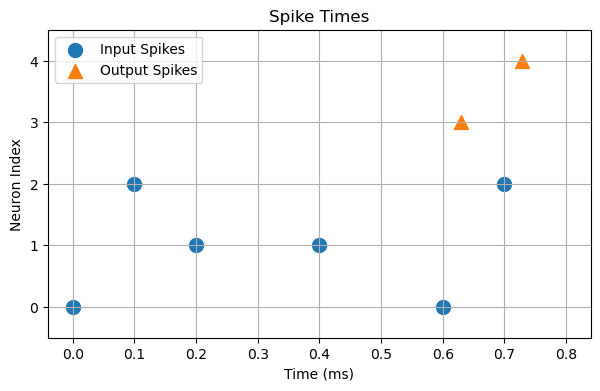jaxsnn#
jaxsnn is an event-based training framework for spiking neural networks (SNNs) implemented in JAX. It provides support for numerical model simulation.
Training of SNNs is done in the init/apply style, where an init function contains the initial parameters and the apply function represents the forward pass as well as the backward pass through the SNN.
Supported Primitives in jaxsnn#
This library does not support conversion of any nodes to NIR.
This library supports conversion of the following nodes from NIR:
Affine
Linear
CubaLIF
Export a NIR graph from NIR to jaxsnn#
from jax import random
import jaxsnn
import nir
import numpy as np
input_size = 3
output_size = 2
np_rng = np.random.default_rng(42)
weight = np_rng.uniform(low=0.5, high=1.5, size=(output_size, input_size))
# Create a simple NIR graph
nir_model = nir.NIRGraph(
nodes={
"input": nir.Input(input_type=np.array([input_size])),
"linear": nir.Linear(weight=weight),
"cubalif": nir.CubaLIF(
tau_mem=np.array([4e-4]*output_size),
tau_syn=np.array([2e-4]*output_size),
r=np.array([1]*output_size),
v_leak=np.array([0]*output_size),
v_reset=np.array([-1]*output_size),
v_threshold=np.array([1]*output_size),
),
"output": nir.Output(output_type=np.array([output_size])),
},
edges=[("input", "linear"), ("linear", "cubalif"), ("cubalif", "output")],
)
# Convert to jaxsnn
config = jaxsnn.ConversionConfig(t_max = 4*2e-4,
n_spikes = {"cubalif": 20})
init, apply = jaxsnn.from_nir(nir_model, config)
Note that here, the apply function performs the forward pass as well as the backward pass (pure simulator).
It is also possible to perform the forward pass externally, e.g. on a BrainScaleS-2 chip or other neuromorphic hardware and use jaxsnn only for gradient computation on the external spike times. This needs to be specified by the external argument in the ConversionConfig object.
Test the network with some input spikes#
import jax.numpy as jnp
from jaxsnn.event.types import EventPropSpike
import matplotlib.pyplot as plt
rng = random.PRNGKey(42)
# Create input spikes
input_spikes = EventPropSpike(
time=jnp.array([0.0, 1e-4, 2e-4, 4e-4, 6e-4, 7e-4]),
idx=jnp.array([0, 2, 1, 1, 0, 2]),
current=jnp.array([0.0, 0.0, 0.0, 0.0, 0.0]))
# Apply the model
_, weight = init(rng, 1)
_, _, output, _ = apply(weight, input_spikes)
# Plot spike times
is_input = output.idx < input_size # Input neurons are indexed 0, 1 and 2
is_output = output.idx >= input_size # Output neurons are indexed 3 and 4
plt.figure(figsize=(7, 4))
plt.scatter(output.time[is_input]*1000, output.idx[is_input], marker='o',
label='Input Spikes', s=100)
plt.scatter(output.time[is_output]*1000, output.idx[is_output], marker='^',
label='Output Spikes', s=100)
plt.title("Spike Times")
plt.xlabel("Time (ms)")
plt.ylabel("Neuron Index")
plt.ylim(-0.5, 4.5) # Adjust x-axis limits based on t_max
plt.grid()
plt.legend()
plt.show()



